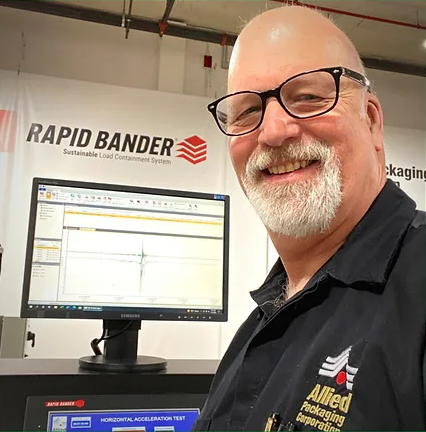Ask Steve
November 17, 2022
Question from Clint: Why do we have load failures, even when we meet our corporate force to load containment standard?
That is a great question Clint, and a very common issue (and one that is not well understood).
First, let’s talk about what load containment is, then how we measure it, finally how effective that measurement is.
Load containment boils down to basic physics. A body (your load) in motion carries inertia based on its mass and velocity. It will remain in motion until a force equal and opposite stops it. You might think, if that is true, we should have perpetual motion machines all around us, and you would be right, however, invisible forces are constantly acting on a body’s inertia, forces like gravity, friction, aerodynamic drag, and so on. Eventually these forces overcome the load’s inertia and its motion will stop.
Now, consider a pallet of boxes on a forklift as it is traveling through your facility. The load (the mass) has inertia based on the speed (velocity) of the forklift, but suddenly the forklift stops, do the boxes also stop? The boxes still have inertia, what stops the boxes from flying all over the warehouse is the stretch wrap you applied. It must provide that equal and opposite force to the load’s inertia. When you consider the dynamic forces experienced during transportation, it becomes much more complex. For instance, if the boxes have some movement after stretch wrapping, the top layers will have more inertia than the ones at the bottom, the higher the load, the more inertia they have due to polar moment of inertia, which is rotational inertia along a specified radius - and in this case, it is the height of the load. One last factor to consider are force vectors (fancy sounding term for the direction of force). It would be much easier if they were all uniform, but as you can imagine, they are not. If the boxes on the top layers move faster than the bottom ones, it creates rotation, which generates a downward force, placing more pressure on the leading edge and removing downward force from the trailing edge. When enough downward force is applied to the leading edge, the boxes collapse, and you have a load failure (sometimes in spectacular fashion).
Now we know what the stretch film is up against when trying to contain a load. For it to be successful, it must unitize the load, preventing any movement of the individual boxes, bundles, pails, or whatever is stacked on the pallet. This will evenly distribute the applied force throughout the load and minimize those downward force vectors that can be detrimental. It must also provide the equal and opposite force to stop the load’s inertia. Oh, did I mention, it must do that without crushing the contents? This is what is necessary for good load containment.
I haven’t forgotten that you need to know why you meet force to load specifications, but still have load failures. It is because Force to Load is just one element when quantifying load containment. Force to load measures how much direct force the film exerts on the load, but that is all. As the stretch film tries to overcome the load’s inertia it continues to stretch, which in turn enables more movement within the load. Since we are now experts in the physics of load containment, we know that those pesky force vectors will not work in our favor if that happens. A quick and easy way to visualize this concept is when you get into your car or travel on an airplane. The first thing you do is buckle your seat belt. You insert the tab in the buckle and pull the strap until the belt is snug. The snug you feel is like the Force to Load you measure on your loads. But what would happen if you locked up the brakes suddenly, and even though your seatbelt was snug, it was made of elastic and continued to stretch? You will make hard contact with the seat in front of you, or the dashboard because the seatbelt was not able to provide an equal and opposite force to counter your inertia. A painful thought, but a good example of why you have load failures even though you meet your corporate Force to Load specification.
So, we can agree that we need more than just Force to Load to quantify or measure load containment.
Time for a quick discussion about the missing link, Total Applied Stretch, or the total percentage that the film is stretched after it is applied to the load. I can hear you ask; why is that important? Stretch film stiffens the more it is stretched. Once you reach a minimum percentage of stretch, the force required to stretch it any further becomes several times greater. If you have 2 pallets sitting on the floor next to each other and both have 15# of force to load, both will meet your containment standard. However, one has 200% Total Applied Stretch and the other has 300%, which one do you think will provide superior containment? You are correct, the one with 300% will provide far greater load containment. And, because you are stretching the film so much farther, you are applying less film to the load. Our technology (Rapid Bander, Rapid Roper, and Rapid Roper Plus) works in that very high level of Total Applied Stretch, taking the elastic out of the film and providing unequalled load containment without having to apply so much force to load that the contents are crushed.
Load containment is far more complex than I have explained today. There are many other factors like center of gravity and center of mass, and how they are affected by applied forces both static and dynamic. But that is for another day…
One last point I want to make, and that is: stretch wrap is one element of successful load containment. Trailer loading patterns, devices to minimize movement in the trailer such as dunnage or airbags, etc. along with using quality pallets all are contributing factors. No matter how much film you put on the load, and no matter how careful you are to make sure all the other elements are in place, there is always the risk that a load will fail when an extraordinary force is applied. As an example, we can generate an instantaneous force to a load of over 40g in our lab. I can assure you that NO load will survive that type of force, no matter how well wrapped it is. But if you consider expanding your load containment standard to also measure Total Applied Stretch, you will be far closer to a meaningful load containment standard. We will be happy to provide you with some guidance.
Thanks for asking,








